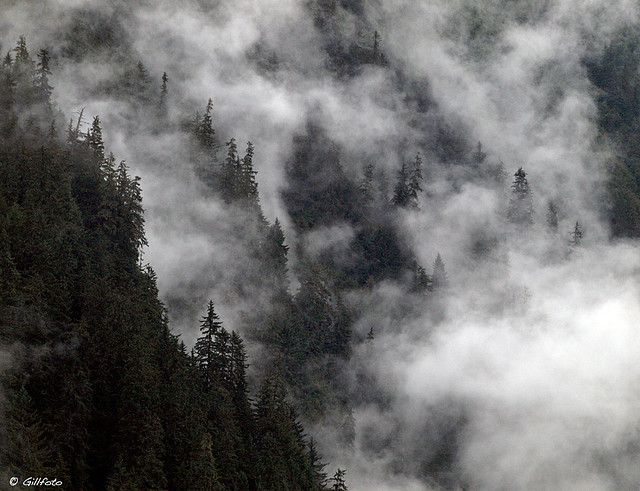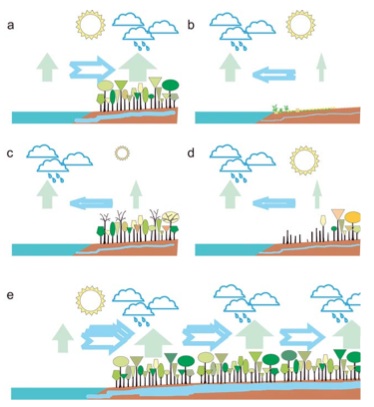
A new theory suggests that forests generate winds to help pump water around the planet. Kenneth J Gill
BOGOR, Indonesia (28 January, 2013)_A new study boosts support for the physics behind a controversial theory that forests play a significant role in determining rainfall, creating atmospheric winds that pump moisture across continents.
The model could revolutionise the way we understand local climates, and their vulnerability, with many major implications. It suggests, for instance, that by strategically replanting forests we could attract rainfall into desert and arid regions like the African Sahel, where drought has for years ravaged crops and induced famine.
Likewise, significant forest loss could transform lush tropical regions into arid landscapes.
“This theory provides us with yet another reason to protect and conserve forest cover,” said Douglas Sheil, co-author of the paper published in Atmospheric Chemistry and Physics and a Senior Associate with the Center for International Forestry Research (CIFOR).
“Traditionally people have said areas like the Congo and the Amazon have high rainfall because they are located in parts of the world that experience high precipitation,” he said.
“But we are proposing the opposite: that the forests cause the rainfall and if they weren’t there the interior of these continental areas would be deserts.”
Scientists Anastassia Makarieva and Victor Gorshkov first published a paper in 2006 outlining the model that forests, by creating low atmospheric pressure, move moist air inland and help generate rainfall.
Sheil and his co-author Daniel Murdiyarso reviewed the importance of the concept in a 2009 article for the Bioscience journal. The new paper, in which Makarieva, Gorshkov, Sheil and others collaborate to outline the detailed physics behind the so-called ‘biotic pump’ hypothesis goes further by emphasising the physics behind how evaporation and condensation generate atmospheric pressure differences.
The model explains why air rises over areas with more intensive evaporation, such as forests. The resulting low pressure draws in additional moist air, leading to a transfer of water vapor that then falls as rain in the areas with the highest evaporation.
 The “biotic pump” model: (a) Under full sunshine, forests maintain higher evaporation than oceans and thus draw in moist ocean air. (b) In deserts, evaporation is low and air is drawn toward the oceans. (c) In seasonal climates, solar energy may be insufficient to maintain forest evaporation at rates higher than those over the oceans during a winter dry season, and the oceans draw air from the land. However, in summer, high forest evaporation rates are reestablished (as in panel a). (d) With forest loss, the net evaporation over the land declines and may be insufficient to counterbalance that from the ocean: air will flow seaward and the land becomes arid and unable to sustain forests. (e) In wet continents, continuous forest cover maintaining high evaporation allows large amounts of moist air to be drawn in from the coast. Source: Sheil and Murdiyarso (2009).
The “biotic pump” model: (a) Under full sunshine, forests maintain higher evaporation than oceans and thus draw in moist ocean air. (b) In deserts, evaporation is low and air is drawn toward the oceans. (c) In seasonal climates, solar energy may be insufficient to maintain forest evaporation at rates higher than those over the oceans during a winter dry season, and the oceans draw air from the land. However, in summer, high forest evaporation rates are reestablished (as in panel a). (d) With forest loss, the net evaporation over the land declines and may be insufficient to counterbalance that from the ocean: air will flow seaward and the land becomes arid and unable to sustain forests. (e) In wet continents, continuous forest cover maintaining high evaporation allows large amounts of moist air to be drawn in from the coast. Source: Sheil and Murdiyarso (2009).
Because the model is contrary to existing climate models, the authors have faced roadblocks getting support from colleagues in the field or finding a publisher.
“It’s hard to convince people that a radical idea like this based on simple physical principles could have been missed for so long,” Sheil said.
“People are certain it is incorrect and don’t want to waste time dealing with it.”
“The challenge is to survive this initial period of hostility — when you are an alien and the whole community is against you, because you want them all to discard some major concept they believe in,” said Makarieva and Gorshkov.
“But thanks to our friends and co-authors we feel that we are no longer alone in this fight.”
“This paper is really trying to bring the physics to formal attention of the climate scientists,” Sheil said.
“We are asking them to disprove this theory and so far no one has been able to do that.”
The editors of Atmospheric Chemistry and Physics decided to publish the paper with an unusual explanatory comment about its ‘controversial’ nature. Vigorous debate has taken place between referees, authors and others, all of which is available online.
This theory provides us with yet another reason to protect and conserve forest cover,”
In explaining their decision to publish, the editors of the journal and the executive committee said they were not convinced that the paper was wrong.
“After very long deliberation… the editor concluded that the manuscript still should be published … to promote continuation of the scientific dialogue on the controversial theory,” the editor’s note stated.
If the theory gains more traction and scientific support, it could have significant policy implications, Sheil added.
“Once you accept this idea that forest cover determines rainfall, there would be a huge amount of policy that would need to created to recognise that value,” he said.
“It also opens up a lot of potential to improve rainfall in dry areas through reforestation. But we would need to invest a lot more effort in research to see the potential extent of the impact of this.”
For Makarieva and Gorshkov, the lesson for forestry policy from their research is clear.
“A policy maker must react promptly to this new knowledge… You are managing one of the hearts of the planet that circulates a thing that is badly needed: water.”
“If we consider an ideal forest policy maker, a long-sighted carer for human well-being, the message is quite unambiguous: spend your life working to completely stop deforestation. Start recovering what can still be recovered.”
We want you to share Forests News content, which is licensed under Creative Commons Attribution-NonCommercial-ShareAlike 4.0 International (CC BY-NC-SA 4.0). This means you are free to redistribute our material for non-commercial purposes. All we ask is that you give Forests News appropriate credit and link to the original Forests News content, indicate if changes were made, and distribute your contributions under the same Creative Commons license. You must notify Forests News if you repost, reprint or reuse our materials by contacting forestsnews@cifor-icraf.org.











